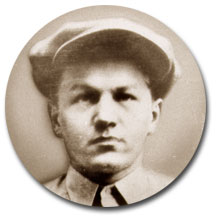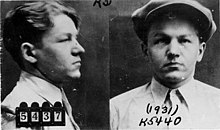Babyface Nelson
Babyface Nelson , actually Lester Joseph Gillis , also known as George Nelson (born December 6, 1908 in Chicago , † November 27, 1934 in Chicago), was an American criminal. Nelson, who owes his nickname to his youthful appearance, was best known for a series of high- profile bank robberies in the 1930s.
Live and act
Babyface Nelson was born in 1908 as Lester Gillis in Chicago, Illinois . Even as a teenager he was involved in criminal circles. After having worked as a car thief for a while, Nelson was arrested for the first time at the age of thirteen and sent to a juvenile reformatory. After his release, he made a living as a petty thief in Chicago. In the late 1920s Nelson was briefly a member of the Al Capone gang , from which he was soon expelled because his quick temper and his inclination to uncontrolled outbursts of violence were considered a security risk.
In 1931 Nelson was arrested again and sentenced to one year in prison. At the beginning of 1932, however, he succeeded in overpowering his guard and escaped during a prisoner transport. A year later, on August 18, 1933, Nelson committed his first bank robbery together with the safe cracker Eddie Bentz : The attempt to clear the First Bank in Grand Haven , Michigan , ended in disaster due to the disorganized actions of the robbers, so that those involved had to flee prematurely and without significant booty.
Nelson gained greater public fame when he joined the gang around bank robber John Dillinger in 1934 . As a result, he participated in numerous successful and bloody crimes, most notably bank robberies. The cruelty and brutality that he displayed in his deeds soon made Nelson a figure notorious among the American public: He is credited with killing more than a dozen police officers and numerous passers-by, which he sometimes did without compelling Reason shot out of sheer aggressiveness. His hatred of the police prompted Nelson to set up his own black list, in which he included information about police officers (license plates, address, etc.) who he then murdered.
Nelson's criminal career ended on November 27, 1934 after an exchange of fire known as the Battle of Barrington between him and two FBI agents outside Chicago, in which the two agents, Herman Hollis and Samuel P. Cowley, were killed. The argument arose when Nelson, while driving with his wife Helen Gillis and his accomplice John Paul Chase, spotted the FBI agent's car - who were driving in the opposite direction and didn't recognize him - and spontaneously decided to attack them. He drove after them, parked their vehicle and began shooting at the agents. At the end of the lengthy exchange of fire, in which Nelson did not seek cover, but ran directly towards his opponents, both FBI agents were dead, while Nelson initially survived despite serious injuries. The fact that he was hit 17 times is probably a myth; in fact, only nine bullets were found, mostly shotgun ammunition. After the exchange of fire, Gillis and Chase fled with the seriously injured Nelson in the FBI agent's official vehicle.
Following an anonymous tip-off, Nelson's body was found the next day wrapped in a blanket in a ditch near the St. Peter Catholic Cemetery in Skokie . His wife later testified that he died from his injuries at 8:00 pm. Nelson is buried in this very cemetery today.
Adaptations from Nelson's life
A few years after his death, Nelson's life became part of American folklore and the sometimes romanticizing memory of gang crime of the 1920s and 1930s. Director Don Siegel processed Nelson's life in 1957 in the film Babyface Nelson ( This is how they all end ), in which Mickey Rooney played Nelson. In 1973 Richard Dreyfuss took on the role of Babyface Nelson in the film Dillinger . Scott Levy presented another interpretation of the material in 1995 under the name Babyface Nelson , in which C. Thomas Howell appeared as Nelson. Most recently, the film O Brother, Where Art Thou? (2000), in which Michael Badalucco plays Nelson. In the summer of 2009 the film Public Enemies started in Germany , in which Stephen Graham embodies the gangster, and which tells the persecution of John Dillinger, him and other criminals.
Bryan Burrough dealt with the crime wave of that time and the FBI's persecution of crooks in his book Public Enemies: America's Greatest Crime Wave and the Birth of the FBI, 1933–34 .
Web links
- FBI famous cases (public domain text)
Individual evidence
- ↑ Inga Ehret: Babyface Nelson. In: Focus Online . August 6, 2009, accessed October 14, 2018 .
- ^ New York Times, November 29, 1934.
- ^ Nelson's death revisited. Retrieved January 4, 2018 (Australian English).
| personal data | |
|---|---|
| SURNAME | Nelson, babyface |
| ALTERNATIVE NAMES | Nelson, George; Gillis, Lester Joseph (real name) |
| BRIEF DESCRIPTION | American gangster and bank robber |
| DATE OF BIRTH | December 6, 1908 |
| PLACE OF BIRTH | Chicago , Illinois |
| DATE OF DEATH | November 27, 1934 |
| Place of death | Chicago , Illinois |

